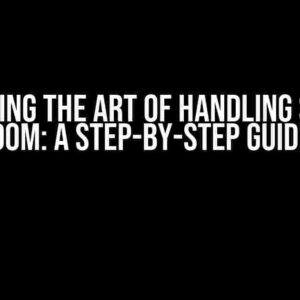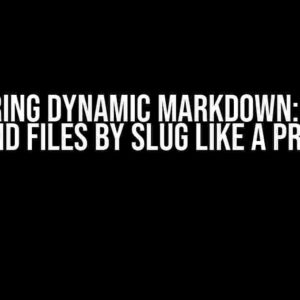Are you tired of struggling with overflowing flexbox children that refuse to scroll when you need them to? Do you find yourself frustratedly clicking and dragging on the scrollbar, only to have the entire webpage scroll instead of the flexbox container you’re trying to navigate? Well, fear not dear reader, for today we’re going to dive into the wonderful world of scrolling flexbox children and explore the solutions to this common problem.
Understanding the Problem
Before we dive into the solutions, let’s take a step back and understand why this problem occurs in the first place. When you have a flexbox container with an overflowing child element, the default behavior is for the child element to overflow outside of its parent container. This is because flexbox is designed to layout elements in a flexible way, without worrying about the container’s dimensions.
However, when you try to scroll the overflowing child element, the browser doesn’t know which element to scroll. Should it scroll the entire webpage, or just the flexbox container? This is where the problem arises, and it’s up to us as developers to provide the necessary instructions to the browser to achieve the desired behavior.
Solution 1: Using the `overflow` Property
One of the simplest solutions to this problem is to use the `overflow` property on the flexbox container. By setting `overflow: auto` or `overflow: scroll` on the container, you’re telling the browser to create a scrollbar for the container, which allows the user to scroll the overflowing child element.
.flex-container {
display: flex;
flex-wrap: wrap;
overflow: auto;
}
This solution works beautifully, but it has one major drawback – it adds a vertical scrollbar to the flexbox container, even when there’s no overflow. If you’re looking for a more elegant solution, read on!
Solution 2: Using the `scroll` Event Listener
Another solution is to use the `scroll` event listener on the flexbox container. This approach allows you to capture the scroll event on the container and prevent the default behavior of scrolling the entire webpage.
const flexContainer = document.querySelector('.flex-container');
flexContainer.addEventListener('scroll', (event) => {
event.stopPropagation();
});
This solution works by stopping the propagation of the scroll event, which prevents the browser from scrolling the entire webpage. However, it requires JavaScript and can be a bit cumbersome to implement.
Solution 3: Using the `pointer-events` Property
A more creative solution is to use the `pointer-events` property on the flexbox container. By setting `pointer-events: none` on the container, you’re telling the browser to ignore all pointer events (such as clicks and scrolls) on the container, except for the overflowing child element.
.flex-container {
display: flex;
flex-wrap: wrap;
pointer-events: none;
}
.flex-container > * {
pointer-events: auto;
}
This solution is elegant and doesn’t require JavaScript, but it has one major limitation – it only works when the cursor is directly over the overflowing child element. If the cursor is anywhere else on the webpage, the flexbox container won’t scroll.
Solution 4: Using the `tabindex` Attribute
A lesser-known solution is to use the `tabindex` attribute on the flexbox container. By setting `tabindex=”0″` on the container, you’re telling the browser to focus the container when the user clicks on it, which allows the container to receive keyboard events (such as scrolling).
<div class="flex-container" tabindex="0">
<!-- overflowing child element -->
</div>
This solution works beautifully, but it has one major drawback – it adds a focus ring around the flexbox container when it receives focus, which can be aesthetically unpleasing.
Putting it all Together
So, which solution is the best? Well, that depends on your specific use case. If you want a simple solution that adds a scrollbar to the flexbox container, use Solution 1. If you want a more elegant solution that doesn’t add a scrollbar, use Solution 2 or 3. And if you want a solution that works with keyboard events, use Solution 4.
Here’s an example of how you could combine Solutions 1 and 3 to create a scrolling flexbox container that doesn’t add a scrollbar:
.flex-container {
display: flex;
flex-wrap: wrap;
overflow: auto;
pointer-events: none;
}
.flex-container > * {
pointer-events: auto;
}
| Solution | Pros | Cons |
|---|---|---|
| Solution 1 (overflow property) | Adds a scrollbar to the flexbox container, allowing users to scroll the overflowing child element. | Adds a scrollbar to the flexbox container, even when there’s no overflow. |
| Solution 2 (scroll event listener) | Prevents the default behavior of scrolling the entire webpage, allowing users to scroll the flexbox container. | Requires JavaScript, can be cumbersome to implement. |
| Solution 3 (pointer-events property) | Allows users to scroll the flexbox container without adding a scrollbar, works elegantly. | Only works when the cursor is directly over the overflowing child element. |
| Solution 4 (tabindex attribute) | Allows users to scroll the flexbox container using keyboard events, works beautifully. | Adds a focus ring around the flexbox container when it receives focus, can be aesthetically unpleasing. |
In conclusion, scrolling an overflowing flexbox child element can be a challenging problem, but with the right solutions, it can be overcome. Whether you choose to use the `overflow` property, the `scroll` event listener, the `pointer-events` property, or the `tabindex` attribute, there’s a solution out there that’s right for you. So go ahead, give them a try, and happy coding!
Here are the 5 Questions and Answers about “How do I scroll in an overflowing flexbox child, when my cursor is anywhere on my webpage?” :
Frequently Asked Question
Get the answers to your most pressing questions about scrolling in an overflowing flexbox child, even when your cursor is somewhere else on the webpage.
Why can’t I scroll my overflowing flexbox child when my cursor is somewhere else on the webpage?
By default, the browser only allows scrolling when the cursor is directly over the element that needs to be scrolled. This is because the browser thinks you want to interact with the element that’s currently under your cursor. To overcome this, you need to use some clever CSS tricks!
What’s the simplest way to enable scrolling in an overflowing flexbox child?
Add `overflow: auto` to the flexbox child element! This will create a new scrollbar that allows you to scroll the content even when your cursor is elsewhere on the webpage.
Can I make the entire webpage scroll when I reach the edge of the flexbox child?
Yes, you can! Add `overscroll-behavior: contain` to the flexbox child element, and set `overflow: auto` on the body or html element. This will create a seamless scrolling experience, allowing the entire webpage to scroll when you reach the edge of the flexbox child.
What if I want to disable scrolling on the webpage and only allow scrolling within the flexbox child?
No problem! Set `overflow: hidden` on the body or html element, and `overflow: auto` on the flexbox child element. This will restrict scrolling to only within the flexbox child, and prevent the webpage from scrolling unintentionally.
Are there any browser compatibility issues with these solutions?
While these solutions are generally supported across modern browsers, you may encounter some inconsistencies in older browsers or edge cases. Be sure to test thoroughly and provide fallbacks for older browsers if necessary!
Let me know if you need any adjustments!








